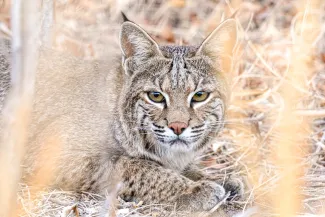The bobcat, a secretive but often sought after furbearer, was the focus of a four-year study that attempted to estimate the predator’s density and trends and establish a means of monitoring the state’s bobcat population independent of fur sales and roadside surveys.
Three of the Wildlife Department’s public hunting areas, James Collins, Packsaddle, and Sandy Sanders Wildlife Management Areas, were the primary study sites, each representing a different ecoregion in Oklahoma. Hair snares and camera traps were deployed at the three areas to estimate bobcat density, and live traps were used to evaluate the small mammal and rodent communities.

Bobcat Status
Bobcats were found to be more densely distributed at James Collins WMA, the study’s most eastern site, than at Packsaddle or Sandy Sanders WMAs.
Despite having 40 hair snare cubbies – small, scented, corrugated plastic tents with 30-caliber rifle bore brushes affixed to the entrances to collect hair – at each WMA for six-week periods in 2019, 2020, and 2021, too few bobcat hair samples were collected to realistically evaluate and monitor the populations using this technique. The camera traps, initially intended to assess the effectiveness of the hair snare traps, yielded better results. Cameras were stationed at more than 100 sites across all study sites and field seasons, generating 134 bobcat observations, or 1.59 bobcats per 100 trap nights. (At this rate, if 100 cameras were active for a single night, a bobcat would only be observed at one site.)
Researchers then identified the number of individual bobcats photographed at each WMA based on distinct patterns in the coats. Twelve individuals were identified at James Collins WMA, resulting in a density estimate of one bobcat per ~750 acres. At Packsaddle WMA, 14 individuals were identified, for a density estimate of one bobcat per ~1,800 acres. And at Sandy Sanders, two individuals were identified, for a density estimate of one bobcat per ~12,000 acres. These densities are similar to those found in eastern Texas, northern Texas, and the Texas Panhandle, respectively.
Bobcats and other small predators are largely nocturnal, but the camera traps showed 16% of bobcat activity occurred during the day, with most daytime observations at James Collins WMA, and 21% of bobcat activity occurred at twilight. While bobcat and coyote activity overlapped significantly, they both differed from the activity patterns of rabbits.
Small Mammal Status
The highest number of rodent species was documented at Packsaddle WMA.
To study the relationship between prey abundance and bobcat densities among the WMAs, researchers used baited live traps to evaluate the rodent populations on each area. More than 350 small mammal live traps were set on each WMA for three consecutive nights from March through May in 2020 and 2021. In all, more than 1,200 rodents – 832 unique individuals – were captured, for a trap success rate of 5.75%. The bulk of the captures were of deer mice, which were found in abundance at each of the study sites and were documented in every sampled habitat type. Harvest mice were the second most frequently captured rodent but were most abundant in grasslands and prairies. Of special note, a meadow jumping mouse, a species of greatest conservation need, was captured at Packsaddle WMA in 2020.
When the small mammal communities of Packsaddle and Sandy Sanders WMAs were compared, Sandy Sanders had higher abundances but 95% of the captures were of smaller-bodied species. Packsaddle had more medium- to large-sized rodents, including ground squirrels and kangaroo rats, that could be more valuable to bobcats. Though James Collins had the lowest predicted abundances of small mammals, the WMA had an abundance of gray and fox squirrels, which may make up a considerable portion of the bobcat diet. Further, the researchers suspect the higher density of tree squirrels and increased vegetation cover at James Collins may allow the bobcats to be more active during the day.
Though the hair snare cubbies were successful in collecting mammal hair, too few bobcat samples were collected and inaccuracies in visually identifying the hair samples to species created too many challenges to use hair snares as a stand-alone monitoring technique. Instead, the research team recommended the Wildlife Department consider a trail camera survey that mixes bobcat images sent in by the public with a more standardized camera survey on Wildlife Management Areas.
Financial support for this project was provided by the Oklahoma Department of Wildlife Conservation through the Wildlife Restoration Program F17AF01257 and Oklahoma State University.